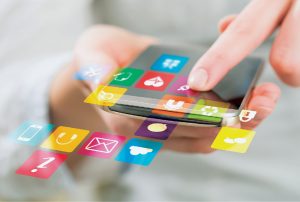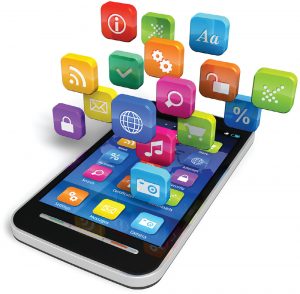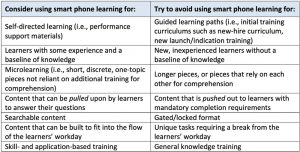Unlocking Smart Phone Learning for Life Sciences
Feature Story – By Ian Kelly
There’s a need for more data about the effectiveness of learning & support delivered on smart phones
Being a learning and performance solutions partner, we often get questions about smart phone-specific mobile learning from our customers. As with most emerging trends in the learning and performance field, smart phone learning presents a conundrum.
- “How can we leverage smart phones in our overall training strategy?”
- “Should we be designing for mobile first?”
- “What’s the best way to support our reps who are always on the road and have limited time?”
The average U.S. adult will spend nearly three hours on their smart phone every day this year according to eMarketer research — and that includes life sciences learners. How will you take advantage of this time and attention to improve your learners’ performance?
Our instructional design team made it a goal this summer to dig deeper on this subject. On the one hand, there’s a sense of urgency (real or perceived) around supporting the phones we carry with us every day. On the other hand, it’s not immediately obvious how to do so effectively — or even where to start.
While our best-practice recommendations for smartphone learning have always been grounded in adult learning theory, instructional design research and our own experience with customers, there’s a need for more data about the effectiveness of learning and performance support solutions delivered on smart phones, as well as the strategies, tactics, and techniques most likely to produce successful outcomes.
 What We Know
What We Know
Nine of the organizations we partner with each year are actively creating and distributing smart phone learning. They are largely doing this using third-party tools (such as Qstream, Axonify, Rcade or Kahoot!) that are distinct from the company’s learning management system (LMS) to create microlearning, assessment or engagement assets. This type of smart phone learning largely serves as either a spaced learning event to increase retention or an engagement tool for a live meeting; it is not meant to deliver introductory content.
A larger percentage of our customers use an LMS that can deliver introductory materials via smart phones. Yet we see organizations struggle to take advantage of this, largely due to increased development cost. While one online course can generally be delivered on both a PC and an iPad, quality decreases when displayed n a small smart phone screen. Short of increasing budgets, we see most customers prioritizing the development of introductory materials for PCs and iPads — and using the remaining funds for the third-party smart phone learning tools described above.
What Does the Research Support?
Some studies, like those from the I/ITSEC Conference and the International Journal of Interactive Mobile Technologies, have shown a neutral to positive result when adapting learning materials to a smart phone learning format (even for material with a longer seat time). This suggests that content can be successfully learned across devices of various sizes.
But … budgets! How should this be practically applied in life sciences training? Despite research showing that smart phone learning can be effective for all types of content, we must be realistic: with limited budgets, phone learning development efforts should be prioritized to create the biggest impact.
The accompanying chart includes some recommendations for smart phone learning.
Topics
We recommend smart phone learning be used primarily for selfdirected learning topics that learners would most likely want to reference during their workday, such as:
Prescribing information
- Clinical studies
- Sales messaging/marketing materials
- Objection handling
- Competitor information
Modalities
We recommend using the following modalities to deliver smart phone learning:
- Quick reference websites built via responsive design
- Mobile games
- Videos
- Coaching apps
- Forums or question boards
It’s worth noting that this list does not include online courses built for the smart phone; instead, we recommend that smart phone learning is designed to be easy to navigate, searchable and provide content that can quickly be pulled upon for information.
Questions to Refine Your Smart Phone Learning Strategy
Making the call to transition into smart phone learning should not be taken lightly or performed quickly. The good news is that you have time. Here are some questions to consider:
 Are your learners ready for smart phone learning? Do they have the necessary technical competence? If not, how can you get them there?
Are your learners ready for smart phone learning? Do they have the necessary technical competence? If not, how can you get them there?- What topics do your learners want to be able to easily reference in the field? What topics do they text or call their peers about? What work-related questions do they research online? This is a great question to start asking your learners to determine your best smart phone learning topics.
- How can your content be chunked into a microlearning format (short, discrete pieces that cover one topic and are not reliant on additional training for comprehension)?
- How can you provide this information as something that can be “pulled” upon, rather than “pushed” out? Do you have the right programming tools to do that?
- How can smart phone learning be built into the flow of your learners’ workday?
- If you are using your LMS and third-party apps to deliver smart phone learning, how do the two systems overlap? Are there ways to make the experience between the two systems more cohesive?
By asking these types of questions, your organization will be better prepared to align with industry best practices and your learners’ needs.
Critical Success Factors
The largest factor that contributes to smart phone learning success is learner perceptions: If learners perceive that the experience is useful, they will be more likely to focus on learning. If not, as you well know, there are a million distractions on a phone that can pull the learner away from the materials.
Other critical success factors, from the Turkish Online Journal of Educational Technology, include:
- User-friendly design of content
- Technical competence of learners
- Learning community development
- Content
- Ownership
Ian Kelly is president of Red Nucleus. Email Ian at ikelly@red-nucleus.com.









